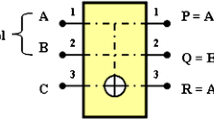Abstract
This manuscript is an attempt to design all-optical reversible arithmetic logic unit. Reversibility will not only help in reducing the errors at the receiving end, but also will increase the multitasking of the optical processors by reducing heat dissipation. At the receiving end of an optical network, conversion of data from optical to electrical takes place for the processing purpose. This kind of processing of data dissipates huge amount of energy in form of heat. This problem can be solved by developing optical processing unit. This manuscript proposed the solution for above-said problem. This kind of processors will simplify the processing by eliminating optoelectronic conversion, but it will also minimize the problem of heat dissipation. The value of average quality factor for this proposed model is 59.98 dB, while the average extinction ratio is 21.26 dB. Optical cost for this proposed model is 4.







Similar content being viewed by others
References
Landauer R (1961) Irreversibility and heat generation in computing process. IBMJ Res Dev 5:183–191
Vos AD (1994) Proposal for an implementation of reversible gates in C-MOS. Int J Electron 76:293–302
Bennett CH (1973) Logical reversibility of computation. IBMJ Res Dev 17:525–532
Paustie AJ, Blow KJ (2000) Demonstration of an all optical Fredkin gate. Opt Commun 174:317–320
Forsati R, Ebrahimi SV, Navi K, Mojoherani E, Jashnsaz H (2013) Implementation of all optical reversible logic gate based on holographic laser induced grating using azo-dye doped polymers. Opt Laser Technol 45:565–570
Mandal D, Mandal S, Garai SK (2015) Alternative approach of developing all optical fredking and Toffoli gate. Opt Laser Technol 72:33–41
Garai SK (2014) A novel method of developing all optical frequency encoded Fredking gates. Opt Commun 313:441–447
Taraphdar C, Chattopadhyay T, Roy JN (2010) Mach–Zehnder interferometer based all optical reversible logic gate. Opt Laser Technol 42:249–259
Arun V, Shukla NK, Singh AK, Singh P (2016) Design and performance analysis of multiple all optical logic gates in a single photonic circuit. Opt Quantum Electron 48(36):1–13
Katti R, Prince S (2016) All Optical new 3 × 3 reversible logic gate using Mach-Zehnder Interferometer. Opt Quantum Electron 48:63
Chattopadhyay T (2012) All optical cross bar network architecture using TOAD based interferometric switch and designing of reconfigurable logic unit. IEEE J Sel Top Quantum 18:585–592
Kotiyal S, Thapliyal H, Ranganathann N (2012) Mach–Zehnder interferometer based design of all optical reversible binary adder. In: Design automation and test in Europe conference and exhibition, pp 721–726
Dutta P, Bandopadhyay, Giri C, Rehman H (2014) In: IEEE computer society annual symposium on VlSI, pp 412–417
Maity GK, Chattopadhyay T, Roy JN, Maity SP (2009) In: International conference on computers and device for communication
Kaminow I, Li T (2002) Optical fiber telecommunication IV A. Academic Press, China
Agrawal GP (2004) Lightwave technology: components and devices. Wiley, Hoboken
Lefevre H (1993) The fiber-optic gyroscope. Artech House, Boston
Connelly MJ (2002) Semiconductor optical amplifier. Kluwer Acdemic publisher, Boston
Giller L, Goober E, Thylen L, Gustavsson M (1989) Semiconductor laser amplifier optimization: an analytical and experimental study. IEEE J Quantum Electron 25:1822–1827
Shancham A, Bergman K, Carloni LP (2008) Photonic networks-on-chip for future generation of chip multiprocessors. IEEE Trans Comput 57:1246–1260
Cherri AK, Al-Zayed AS (2009) Circuit design of ultrafast all optical modified signed digit adder using semiconductor optical amplifier and Mach–Zehnder interferometer. Optik 121:1577–1585
Author information
Authors and Affiliations
Corresponding author
Additional information
Publisher's Note
Springer Nature remains neutral with regard to jurisdictional claims in published maps and institutional affiliations.
Rights and permissions
About this article
Cite this article
Upadhyay, K.K., Srivastava, S., Arun, V. et al. Design and Performance Analysis of All-Optical Reversible Full Adder, as ALU. Proc. Natl. Acad. Sci., India, Sect. A Phys. Sci. 90, 899–909 (2020). https://doi.org/10.1007/s40010-019-00611-w
Received:
Revised:
Accepted:
Published:
Issue Date:
DOI: https://doi.org/10.1007/s40010-019-00611-w




